THE JUBILATION OF JUNE
The month of June is a joyful time. It’s lightning bugs flickering in the gloaming and kids chasing after them. It’s hard work hoeing out gardens and trying to keep up with a time of rapid growth for wonderful vegetables and wretched weeds. It’s blackberries turning red before reaching full black ripeness. It’s scratched hands from picking them and big grins from eating a cobbler. It’s the first mess of Silver Queen corn from the garden and, in this part of the world, the first ripe tomatoes. It’s days filled with too much to do, too much humidity, and too few hours to get everything done (at my age, it’s also too little energy to work like I once did).
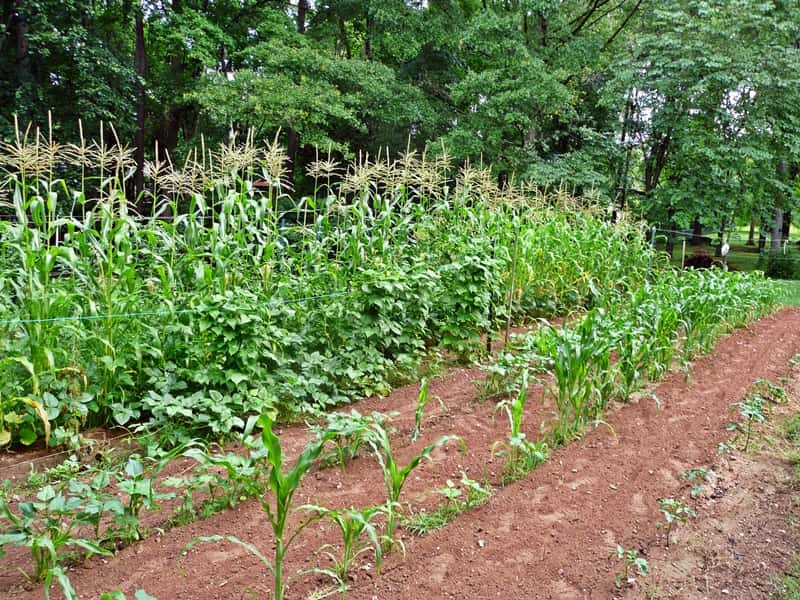
View of big garden (which is less than pristine)
June means that laying by time is at hand, although I don’t think the term is used much anymore. When I was a boy growing up in the Smokies, you had your crops “laid by” when they reached sufficient maturity so no more hoeing, plowing, or weeding was required. This applied especially to fields of corn and the accompanying corn field beans and pumpkins, but the word usage also referred to the juncture where most folks sort of let their gardens go. They were at a point where the vegetables would hold their own without further dealing with weeds.
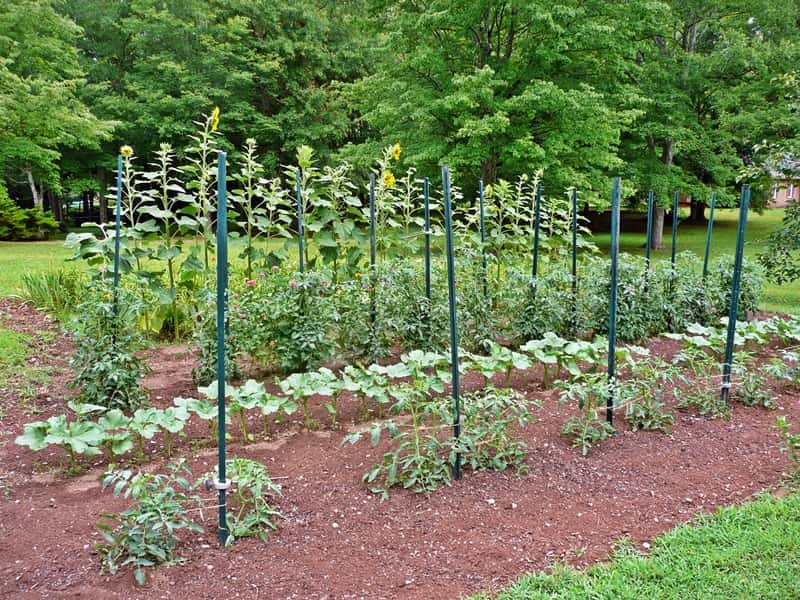
View of small garden, neatly weeded and clean
Nowadays I try to keep the weeds at bay even after plantings reach that point, but I must admit that I’m less diligent than I should be. It’s one thing to follow a tiller up one row and down the next and quite another one to work the tight spots around plants with a hoe or weeding by hand. Still, I make an effort to keep weeds somewhat in control, and in a small patch I have close to the street that’s particularly true. I figure the neighbors don’t want to look at a patch of thriving weeds. Traditionally I’ve devoted this little plot strictly to flowers, but this summer I’ve put about two dozen tomato plants and a row of okra, along with a row of sunflowers as a backdrop, there instead. Where possible I left volunteer zinnias. Deer leave them alone, although the same can’t be said of the day lilies at the edge of this plot. Deer have eaten virtually all the buds just before the flowers open. Along with squirrels, they are the bane of my gardening existence. I think I’ll get out a package of cubed venison steak to thaw just to show the whitetails that I’ve had a permanent measure of revenge on some of their marauding brethren!
For me, right now, June means real blessings on the table. There’s more squash than I know what to do with, but thus far I’ve managed to give enough away to keep from being swamped. My Nantahala runner beans, an heirloom variety stretching back to the Carolina high country with a history of well over a century (I got them from a friend, Ken Roper, who had in turn gotten them from someone else who gave him their story—they trace to the tiny mountain community of Nantahala, hence my name for them), are bearing like no body’s business. They’ll continue to do so as long as I keep them picked and keep the bean beetles at bay, for they are an amazingly prolific plant. My creasy (or greasy back, as mountain folks sometimes style them) runner beans are thriving but they won’t be ready for ten days are so. There are small pumpkins aplenty on my Chambers Creek ones (another mountain heirloom plant). I’ve had the first ripe tomatoes from Carolina Gold plants. While they are welcome, I won’t plant them again. It was my first time and the taste is rather bland.
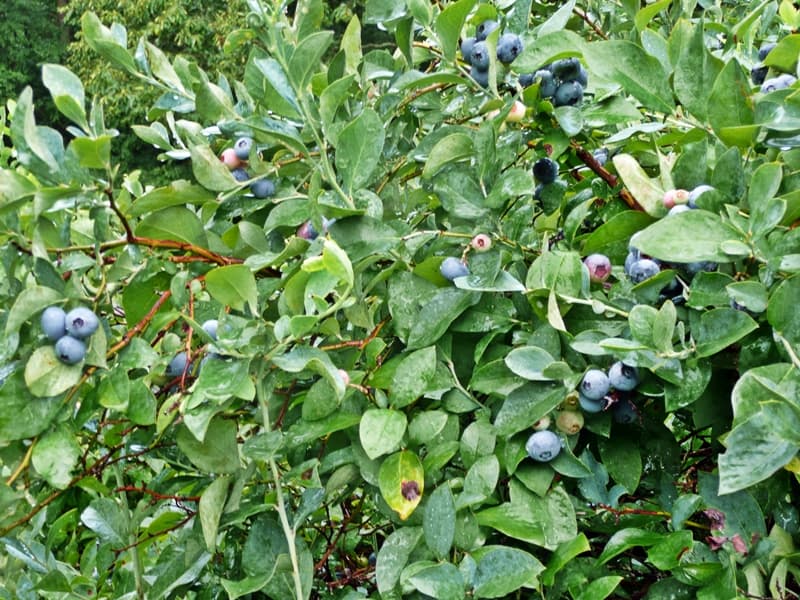
Blueberries aplenty
I’ll have eggplant by the time you read this and okra won’t be much behind. Right now though, my biggest challenge, and a most welcome one, I might add, is keeping up with the blueberries. Every year I have lots of them go to waste, thanks to too many plants, lots of which are volunteers planted by bird droppings, and the fact that picking is a slow process. However, this year my berries are extraordinarily large. I think it’s a combination of a great deal of rain and the fact that because of a lot of chilly, cloudy days when they were in bloom, not so much fruit setting as usual. Even with a crop which is sparser than some years, I’ll have gallons wasted. As difficult as it is to keep up with blueberries, another favorite just now coming in, figs, are easy-peasy when it comes to picking. Alas, both birds and squirrels feel it is their bounden duty to help me with the harvest.
Incidentally, if any of you have recommendations for keep squirrels at bay, I’d sure welcome your input. I never get any pecans, they gnaw on pears, sometimes eat tomatoes, and are pure poison on corn just as it gets into the milk stage. I’ve tried traps, a pellet gun, hot pepper, and more to little avail. Bushytails are bright and quick learners, and now all I have to do is come in sight with a pellet gun in hand and they suddenly light a streak for the next county. Similarly, catch one or two in a trap and they avoid it like the plague. I’m dealing with literally scores of the rascals, and sometimes I can walk out in the yard and see half a dozen or more at once. Maybe they are repaying me for all the pressure I put on their ancestors when I was a boy.
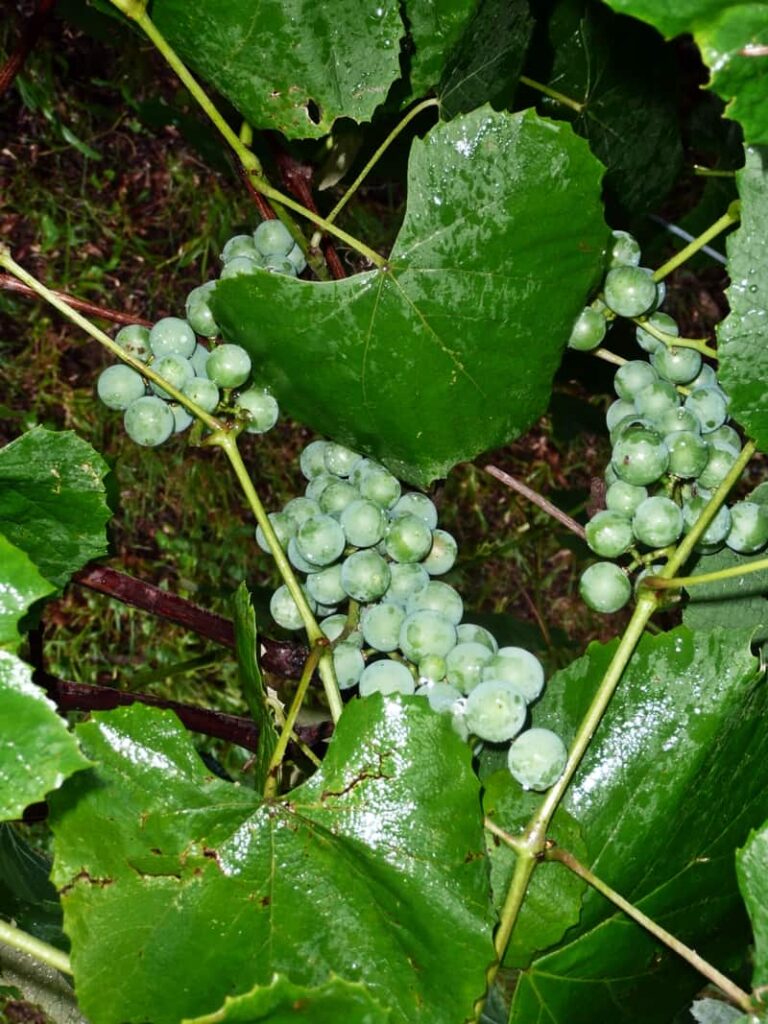
Clusters of Concord grapes
One other thing about June. I love to walk around in the cool of coming twilight and just look at how things in the garden, along with my vines and fruit trees, are doing. It’s a good way to detect problems early on (I just yesterday squashed that green brother of Beelzebub, a tomato horn worm, when such meandering led to my noticing major munching on a plant). Likewise, I can admire clusters of Concord grapes which will ripen in early August, muscadines and scuppernongs which will come along three weeks or so later, keep an eye out for anything I might have missed in the daily morning harvest, admire flowers in bloom, and just generally bask in the glories of being a gardener.
Of course there’s more to June than the garden. It’s a fine month for fishing, and bream are on the bed not only in May but through June and on into the summer. I always had a wonderful time with trout during June as well, with warming mountain waters and weather combining to make wading wet possible though still invigorating. The first watermelons showed up in grocery stores or more often arrayed on the back of a truck parked in a handy spot alongside the road. Most of them came from deep down in Georgia, and when I was down in that area on some business a couple of weeks back seeing a crew out in a field harvesting watermelons took me straight back to boyhood, the lusciousness of a big Georgia cannonball melon, seed spitting activities (and Grandpa’s chickens scrambling to gobble up every seed we spat), and just being with Grandpa Joe. We had some wonderful times, many of them involved with garden work, but also making slingshots, fishing, and me listening to him relive the past from his rocking chair throne after a day outside in the heat. What I wouldn’t give to have had a tape recording of some of those tales, although goodness knows I’ve done my best to relive some of them in print over the decades.
June meant dinners of incredible variety, cold suppers, the first peaches, and Momma and Grandma Minnie beginning to can garden truck. The latter would continue right through the summer until they had truly impressive arrays of quart jars lining the walls of the basement at our house and those of the cannery at Grandma’s. June apples would ripen right at month’s end and between a tree in her yard and another one right across the street at the house of a widow woman who gave Grandma most of the fruit, there was some might fine eating to be had. I picked up some welcome pocket money mowing lawns, did more than my fair share of catching catfish with an old codger named Al Dorsey who it turns out had murdered a man many years earlier, went barefooted all the time, put pennies on the railroad tracks to be flattened by trains, rode my bike endless hours, went swimming in the creek a great deal, played pick-up baseball (I was out of high school before the first formal Little League came to our area), enjoyed pickin’ and grinnin’ on Friday nights and square dances on Saturdays once I reach my mid-teens, and generally lived a kind of life which really isn’t available to children today.
It’s that life I try to recapture and describe in A Smoky Mountain Boyhood (see more below), and one of the approaches taken in the book is to look longingly back to what each month held in store and what they meant to me growing up in the 1950s. I’ll simply say, as I wool-gather and look back, that my boyhood, not just in June but in every month, was a time filled with wonder, wonderful things, and wonderful people.
JIM’S DOIN’S
This time of year there’s considerable sameness to my lifestyle under ordinary circumstances, and this COVID-19 mess has made the sameness even more predictable thanks to the fact that a very basic routine has, like it or not, taken over my life. Most days the greatest distance I get from this computer is to the outermost limits of my three-acre lot. I usually try to limit my trips to the post office to mail books to once and week and coordinate them with any other errands needing my attention. Similarly, once a week (at most) does it for grocery shopping. Otherwise I’m up early, spend a couple of hours in the yard or garden until it’s too hot, come in for a late breakfast, and spend the remainder of the day writing, reading, researching, or, honesty compels me to admit, just plain piddling. Come deer season, of course, I’ll get away to my 100-acre piece of land in the adjacent county fairly regularly.
After some troublesome developments connected to more than a foot of rain in May, things have stabilized with the garden. Thus far, between a noxious-smelling spray and a three-tier fencing arrangement, I’ve managed to keep the deer away. Squirrels are another matter and if anyone has the secret, short of a .22 rifle, to keeping them out of sweet corn, let me know. I’m absolutely overrun with ‘em, and one even gnawed a huge bloom off a sunflower. For now, I’m eating green beans, the first tomatoes, and squash out of the garden and will have okra within a week. Crowder peas and several other things aren’t far behind.
I’m expecting proofs for A Smoky Mountain Boyhood: Memories, Musings, and More any time now, and the Fall/Winter University of Tennessee Press catalog promoting it is already on-line. I’ll be sending additional details in the next couple of newsletters. I’ve had a few things appear in print since the last newsletter. Most notable among them is a lengthy profile of Archibald Rutledge, ““Old Flintlock: A Sporting Scribe for the Ages,” in the July/August edition of Sporting Classics, on pp. 145-52. The same issue also carries my regular book column, this one devoted to “The Literary Legacy of W. Robert Foran,” on pp. 61-66. I continue to make periodic contributions to “Sporting Classics Daily,” with the most recent one being “Did You Ever? Vanishing Aspects of Youth in Yesteryear,” in the June 9, 2020 issue.
Beyond that, I continue to try to place a cookbook manuscript (which is completed), am looking for a home for a second one which would be co-authored with my webmaster, Tipper Pressley; have several assignments and/or forthcoming stories in one of the loveliest magazines I’ve been privileged to write for over the years, South Carolina Wildlife; and will have a series of food-related columns in upcoming issues of Smoky Mountain Living.
RECENT READING
I’ve been on a biography and autobiography binge in my reading lately, and it’s likely my tastes run in directions quite different from most of yours. I recently completed Percy Clark’s The Autobiography of an Old Drifter (mostly set Rhodesia, as today’s Zimbabwe was once known); a book by the noted traveler/explorer Wilfred Thesiger along with Alex Maitland’s biography of him; Ursula Buchan’s first-rate life of her grandfather, John Buchan, the prolific Scottish writer who gave us many delightful mysteries as well as books on history, biographies, and more; and a life of the nineteenth-century African explorer, Mary Kingsley, by Katherine Frank. My research and writing specialty, back in my academic days, was exploration, and many of these books are linked to that still prevalent interest. I don’t do much writing in the field, other than the occasional piece on an African explorer who was also a great hunter, but the appeal remains.
*******************************************************************************
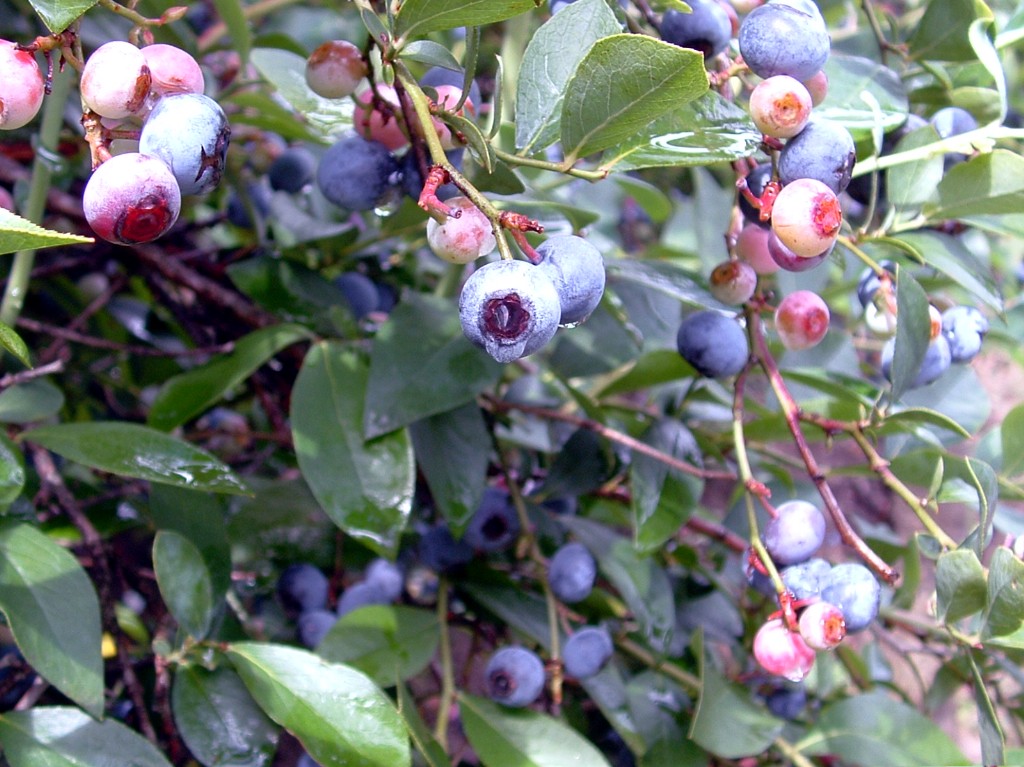
BLUEBERRY BOUNTY
Right now I’ve got blueberries aplenty and then some. I eat them with cottage cheese, by themselves, atop cereal, and right now my dehydrator has its five shelves drying a batch. Still, I’m always overwhelmed so recipes using them are part of the equation. Here are a couple I really like.
BLUEBERRY SALAD
2 cups fresh blueberries (plus a third cup for juice)
1 (6-ounce) package black cherry gelatin
1 cup water
1 (8 ½ ounce) can crushed pineapple (do not drain)
1 small carton whipped topping
1 (3-ounce) package cream cheese, softened
½ cup finely chopped pecans
Crush a cup of blueberries and add enough water to them to make juice and heat to boiling. Add gelatin and stir until dissolved. Add a cup of cold water, pineapple, and fresh blueberries. Pour into a 9 x 13-inch dish and refrigerate until firm. Beat softened cream cheese, add nuts, and fold in whipped topping. Mix well. Spread over congealed salad and chill for at least two more hours before serving.
**********************************************************************************
FRESH BLUEBERRY PIE
1 baked 9-inch pie shell (pastry or graham cracker)
4 cups fresh blueberries, divided
1 cup sugar
3 tablespoons cornstarch
¼ cup water
¼ teaspoon salt
¼ teaspoon cinnamon
1 tablespoon butter
Line pie shell with two cups of the fresh blueberries. Cook the remaining two cups of berries with sugar, cornstarch, water and salt over medium heat until thickened. Remove from heat, add cinnamon and butter, and cool slightly. Pour over berries in shell. Refrigerate. Serve with whipped cream topping.
********************************************************************************
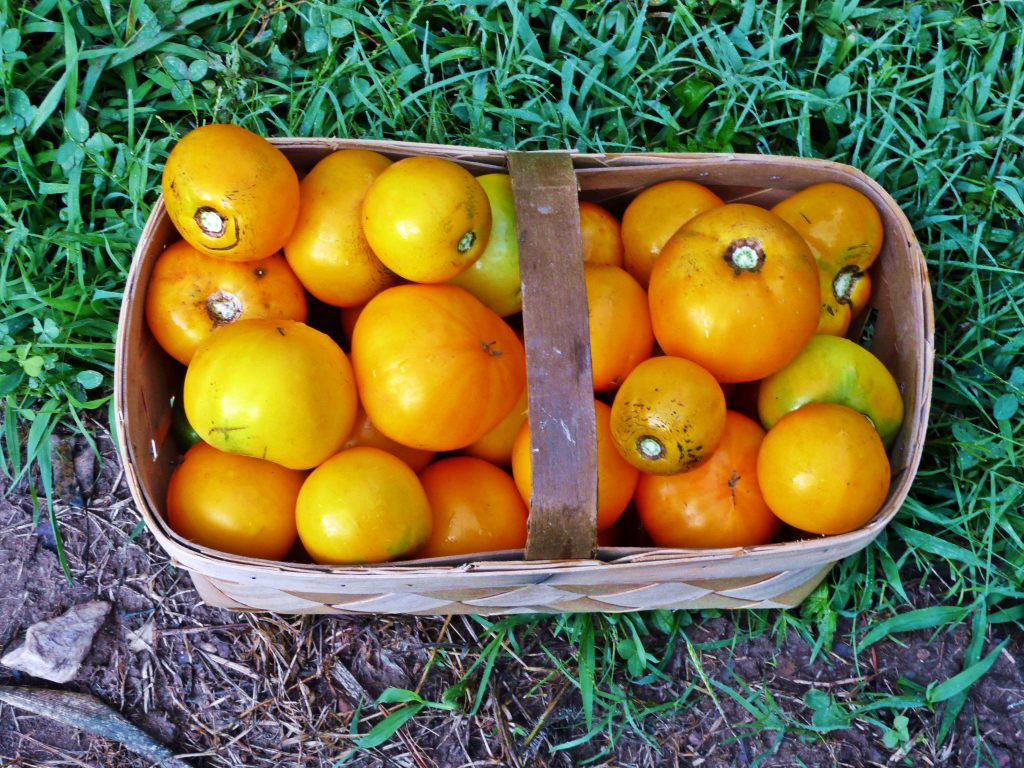
MAKIN’S FROM MATERS
I shared several tomato recipes last month, but here are some more. Tomatoes are so versatile, so healthy, so delicious, and in a typical year for me so plentiful, that I try to utilize them in a wide variety of ways. A passel of tomato recipes appear below, in part because I consider them, along with corn, the quintessential items from a mountain garden. Before that though, some thoughts on the keys to producing successful tomatoes seem merited. They are an accumulation from Grandpa, Daddy, various gardeners of my acquaintance, and more than a half century of planting and working my own garden. Tomatoes have always been a part of it, and I’m always experimenting with new varieties, different ways of suckering (or not suckering), rooting suckers for late plants, trying different support systems, and more. Here are some thoughts from my findings.
*Rotate where you plant tomatoes from year to year. That helps keep various problems with blight at bay.
*Leave ample room between the plants. That lets the plants breathe and works against too much moisture build-up and the progression of various tomato diseases.
*I stake my plants religiously (using eight-foot metal fence posts) and prune them relentlessly. I leave the sucker below the first bloom cluster and thus have two main stems, but all other suckers are removed. Exceptions are Roma-type tomatoes and tommytoes. I don’t prune them at all and in the case of the latter keeping them supported is a real problem. They’ll run out the top of an eight-foot stake in no time at all.
*I don’t use any Sevin or other treatments but I do plant marigolds between the tomato plants, spray with soapy water when aphids appear, and apply bacillus thuringiensis as soon as I notice any sign of tomato hornworms. When I see the tell-tale signs of their depredations the search is on (fresh droppings help in locating these masters of camouflage). When I locate the hornworm there’s a good squishing, with green juice a-flying, to send the pest the insect paradise, and treatment follows in case any of his kinfolk are around.
*Perhaps the best tip I can offer involves removing leaf stems as soon as they show any sign of yellowing, black spots, or disease. They will usually tear or break away from the main vine fairly easy. By mid-summer the lower reaches of plants look naked, but I’m convinced it works not only in keeping the spread of disease at bay but in letting the plant put its energy into producing more tomatoes as the season advances. Don’t throw the diseased vegetation on the ground. I carry a five-gallon bucket with me and put the leaves in it as I move down the row. They then go straight to my burn pile at a good distance from the garden.
*Keep the ground beneath the plants clean and free of weeds. I think mulch is a mistake because it makes a perfect home for disease. If it gets really dry and you need to water the plants, do so early in the day so that moisture on the plant will dry before nightfall.
*The varieties you plant are largely a matter of personal choice, and no two seasons find me with exactly the same types. That being said, I always have some Cherokee Purples, Lemon Boys, Sweet 100s (or just volunteer tommytoes), Romas, Black Krims, Mr. Stripey, and Beefmasters. Beyond that different heirlooms are most likely, although in my experience they aren’t as productive as many of the hybrids. They more than offset that with taste. I normally plant a total of about three dozen of the above-mentioned varieties, always trying to grow at least one previously untried heirloom variety. For my “late” tomatoes I root from suckers in potting soil, often using a bit of rooting hormone, although it isn’t essential as long as you make sure the soil in which you place the “cuttings” has adequate moisture Obviously I grow a lot of tomatoes, and in good years I’ve literally given away bushels after putting up all I need. But between drying, freezing, and canning, not to mention use in soup mix, a lot of the tomatoes never “leave home.” Here are some of the endless ways to enjoy them .
MINI TOMATO PIES
INGREDIENTS
Phyllo shells
Sweet onions
Virgin olive oil
Fresh basil
Large slicing tomatoes
2 cups sharp cheddar cheese (Cabot’s Seriously Sharp is a good choice)
Salt and freshly ground black pepper
¾ cup real mayonnaise
Pre-bake individual phyllo shells. The number can vary, as can the amounts given below, depending on how many servings you want, but one pie per person is your guide. As the shells are baking, slice tomatoes fairly thin and lay them atop paper towels. Lightly salt the tops and let sit ten minutes before patting dry. Shred the cheese, adding salt and pepper to taste (remember that the tomatoes have been salted and even though patting will remove some of it a salty tang will remain).
Sauté sliced onions in olive oil. Mix mayonnaise with the cheese. Begin with a layer of tomatoes, then one of the cheese mixture, then onions and basil. Continue layering until each phyllo shell is filled to the top. Bake at 375 degrees for 30 minutes or until done.
*******************************************************************************
TOMATO DILL SOUP
INGREDIENTS
1 stick butter
1½ large sweet onions pureed in a food processor
¼ cup fresh garlic, minced
1½ teaspoons dried dill
¼ tablespoon kosher salt
1/8 tablespoon freshly ground black pepper
9 cups tomatoes (crushed or diced—that equates to two 28-ounce cans plus one 14 1/2–ounce can—tomatoes you have grown, frozen, and thawed out are ideal for this recipe)
3 cups water
2 cups heavy cream (a pint of half-and-half with some whole milk added will work)
Place butter, onions, garlic, dill, salt and black pepper in a large covered pot. Sauté on low heat until onions are translucent. Add tomatoes and water. Simmer for one to two hours. Remove from heat and blend in cream.
*************************************************************************************
STEWED TOMATOES AND OKRA
Cut a small cross or plus sign at the bottom of several dead ripe tomatoes and then dip in hot water for 15 to 30 seconds. This will loosen the skin and allow you to peel it away with ease. Cut out the core and quarter the peeled tomatoes. Set aside briefly while you prepare okra pods by cutting away the stem area. Pods can be cut into one-inch slices or left whole. Combine with the previously prepared tomatoes in a large cooking pot, add salt to taste along with a couple of slices of fried streaked meat (if desired), and simmer slowly (do not overcook, because everything will turn to mush). This dish does not look particularly appealing, and for some folks the slick or slimy nature of stewed okra is a turn-off. Visual aesthetics aside, this as a grand vegetable dish. Leftovers can be used as the starting point for a big pot of vegetable or vegetable-beef soup.